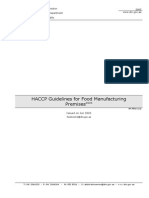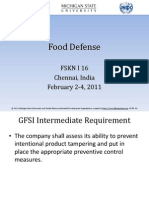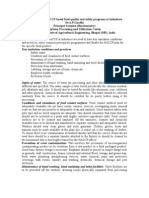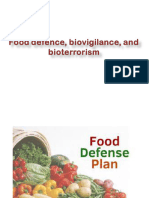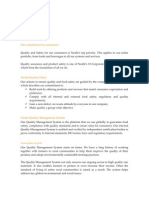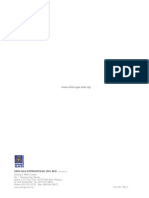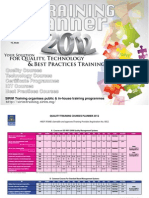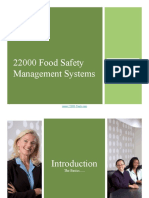Basics of HACCP and Prerequisite Programs
Basics of HACCP and Prerequisite Programs
Uploaded by
Anonymous A1G77Sw59Copyright:
Available Formats
Basics of HACCP and Prerequisite Programs
Basics of HACCP and Prerequisite Programs
Uploaded by
Anonymous A1G77Sw59Copyright
Available Formats
Share this document
Did you find this document useful?
Is this content inappropriate?
Copyright:
Available Formats
Basics of HACCP and Prerequisite Programs
Basics of HACCP and Prerequisite Programs
Uploaded by
Anonymous A1G77Sw59Copyright:
Available Formats
Basics of HACCP and Prerequisite
Programs
Implementing an effective HACCP Program and prerequisite programs to ensure
a environment that is capable of producing safe product is the first step to
building a Food Safety Management System (FSMS)
Copyright 2014 Vinca, LLC
Introduction to Vinca LLC and
22000-tools.com
Cynthia Weber, our president, is an SQF Registered Consultant and FSSC
22000 Lead Auditor for the Food Processing and Food Packaging
Manufacturing industries.
Ms. Weber's 25 years of experience and expertise implementing Food
Safety Management Systems is available to you in the
Online Tools and Training we offer, and through the customer support we
provide to customers throughout your implementation project.
Vinca is here to help you achieve GFSI recognized Certification for food
safety management systems. Our customers use Online Training and
Development Tools to learn and train staff, and to design and implement
systems for:
SQF
FSSC 22000, and
BRC
Achieve Certification without using a consultant. Our online training
programs walk you through each step of designing, documenting and
implementing your system so you are ready for your certification audit.
Versions are available for Food Processors, Pet Food Processors and
Food Packaging Manufacturers.
You may register for the courses one by one, or order the complete series
for the standard you choose in our "Complete Training Package".
For a facility-wide training solution, order our "Premium Package". This
package provides your project leader with the complete training and
multiple log-ins to allow you to train others in your management team,
food safety team and internal audit team.
For multi-site organizations we can provide a Corporate Solution. Contact
us for a custom quote for Premium Packages for each site, 800-746-3174.
www.22000-tools.com
Basics of HACC and Prerequisite Programs
Copyright 2014 Vinca, LLC
Introduction to HACCP
Hazard Analysis and Critical Control Point (HACCP) is an
internationally recognized system for reducing the risk of safety
hazards in food.
A HACCP System requires that potential hazards are identified and
controlled at specific points in the process.
Biological
Chemical
Physical
Any company involved in the manufacturing, processing or handling
of food products can use HACCP to minimize or eliminate food
safety hazards in their product.
What HACCP is not:
HACCP is not a Quality Control system
HACCP is not a government program (although there are
regulatory requirements for companies to have a HACCP
program in place. Visit FDA.gov for information)
Building a HACCP System
Implementing a HACCP System requires that both Prerequisite
Programs and HACCP Plans are implemented.
Prerequisite programs are programs that are put in place
in the facility to control hazards in the environment,
preventing contamination of the product. Prerequisite
programs ensure a hygienic environment, and good
manufacturing processes for personnel that reduce the risk
of contamination of the food product.
HACCP Plans are prepared for each process or product,
and identify possible hazards and controls in place to make
sure the hazards are eliminated or controlled to ensure
acceptable levels in the food product.
Basics of HACC and Prerequisite Programs
Copyright 2014 Vinca, LLC
Hazard Analysis and Critical
Control Point (HACCP)
identifies controls for specific
hazards in the manufacturing,
processing or handling
process.
Prerequisite Programs are
programs to control hazards
in the food manufacturing,
processing or handling
environment.
Why use HACCP?
Awareness of food-borne illness is increasing and concern
throughout the industry is driving the use of HACCP and HACCP
based certification programs.
Global market place
Increasing incidents of food-borne pathogens
New pathogens emerging
Need to protect Brands, control risks
Food Safety Management Systems
To protect themselves, multinational food manufactures, retailers
and grocers are asking their suppliers to implement a Food Safety
Management System.
The Global Food Safety Initiative, GFSI has benchmarked a
number of Food Safety Management Systems Certification
programs, all of which are HACCP based.
SQF
FSSC 22000
BRC
IFS
Others
Benefits of HACCP
The primary purpose of a HACCP system is to protect people from
food borne illness, but the benefits of the system also extend to the
company.
Increased confidence in your products
Ability to reach markets and customers that require a
HACCP based system
Reduced Liability
Effective process management
Improved quality and consistency
Basics of HACC and Prerequisite Programs
Copyright 2014 Vinca, LLC
Outbreaks of food borne
illness hurt companies
throughout the food
chain. When a one brand
is recalled, all brands
with similar products can
suffer.
One of the first steps to building a food safety management system is to
establish your HACCP Plan. Use our HACCP Tools Package to guide you
through the design and implementation of your program.
The package is available in three formats based on the three popular
GFSI recognized certification schemes. Choose the package for the
standard you plan to obtain certification for, or use any of these as a
generic HACCP program.
http://www.22000-tools.com/haccp-package.html
The HACCP Tools Package includes
Prerequisite Programs Procedure
HACCP Procedure
Excel HACCP workbook to develop and document your HACCP Plan
Basics of HACC and Prerequisite Programs
Copyright 2014 Vinca, LLC
Prerequisite Programs
Introduction
Prerequisite Programs are programs and practices that are put in
place to maintain a sanitary environment and minimize the risk of
introducing a food safety hazard.
Provide suitable building and equipment design and
construction
Plan and Implement Pre-requisite programs
Address statutory, regulatory and customer requirements as
well as other recognized guidelines
Learn more about prerequisite programs for GFSI
recognized certification programs
o
http://www.22000-tools.com/sqf-food-safety-
fundamentals-training.html
o
http://www.22000-tools.com/fssc-22000-prp-
training.html
o
http://www.22000-tools.com/brc-introduction-to-brc-
training.html
Consider the points below as you plan your prerequisite programs.
If you are implementing a Food Safety Management System for
certification, follow the prerequisite program requirements in the
relevant standard.
Building and Equipment Design and Construction
Detailed requirements for the building and equipment construction
and design requirements
Site Requirements and Approval
Food Handling Areas
Water and Ice Supply
Storage Facilities
Separation of Functions
On-site Laboratories
Staff Amenities
First Aid Facilities
Waste Disposal
Exterior
Basics of HACC and Prerequisite Programs
Copyright 2014 Vinca, LLC
The first step to building an
effective HACCP Program
is to establish programs
and practices that ensure a
clean hygienic environment
for your product processing
or handling.
Consider your building and
equipment. How do they
contribute to the safety of
your product?
Site Requirements and Approval
Your facility and site must be located so that other operations
nearby do not jeopardize the safe and hygienic operations at your
facility.
Evaluate possible hazards in the area and establish
control measures if needed
Validate the efficiency of measures put in place
Monitor and periodically review the measures
Obtain approvals from relevant authorities for the
construction and operation of your facility
Food Handling Areas
Use surface materials that do not contribute a food safety risk, are
smooth, easy to clean, and not damaged by cleaners:
Product contact surfaces
Walls
Ceilings
Floors
Floors, Drains and Waste Traps
Floors in food handling areas must be:
Smooth
Impact resistant
Graded and drained
Impervious to liquids
Easily cleaned
Drained
Walls, Partitions, Doors and Ceilings
Internal surfaces in food handling areas must also be
Durable
Smooth
Impervious
Use light colored finishes to enable cleaning to be evaluated.
Walls, Partitions, Doors and Ceilings
Round junctions for easy cleaning and to prevent food debris
accumulating. If junctions are not rounded, document a cleaning
process.
Basics of HACC and Prerequisite Programs
Copyright 2014 Vinca, LLC
Ducting, Conduits and Pipes
Prevent contamination from dust or material buildup on pipes by:
Recessing into walls or ceilings, or
Mounting far enough away from surfaces to allow for
effective cleaning
Doors, Hatches and Windows
Requirements are that:
Doors and hatches must be solid
Windows must be shatterproof glass in processing or
food handling areas
Pest and fly proof windows
Ceilings must be in place to prevent contamination of
product
Stairs, Catwalks and Platforms
When in food handling areas:
Design and construct to prevent contamination risks
If they cross over production or processing areas
make sure that the structure and the traffic do not
contaminate the areas underneath
Lighting and Light Fittings
When in food handling areas:
! Lighting must be sufficient, and appropriate intensity
for people to carry out tasks
Inspection Area
Provide a suitable area if inspection of product in the processing
area is needed:
Easy access to hand washing facilities
Sufficient lighting for the inspection of product
Basics of HACC and Prerequisite Programs
Copyright 2014 Vinca, LLC
Dust, Fly and Vermin Proofing
Prevent access by:
Making sure openings are effectively sealed when
closed
Providing personnel access doors fitted with self
closing device and fly proofed
Fly proofing external doors
Locating pest control devices so they do not pose a
risk of contamination
Ventilation
Provide adequate ventilation
In enclosed processing and food handling areas
In cooking areas
Use extractor fans and canopies where large amounts
of steam are generated
Equipment, Utensils and Protective Clothing
Minimize the risk of contamination from equipment:
Equipment
Design and construct of appropriate materials, and
make them easy to clean, dismantle and properly
maintain
Equipment, Utensils and Protective Clothing
Minimize the risk of contamination from utensils:
Utensils such as containers, tubs, bins
Constructed of non toxic materials, smooth and easy
to clean
Equipment, Utensils and Protective Clothing
Minimize the risk of contamination from drainage:
Equipment that drains
Make waste and overflow water discharge directly to
floor drainage systems
Basics of HACC and Prerequisite Programs
Copyright 2014 Vinca, LLC
Equipment, Utensils and Protective Clothing
Minimize the risk of contamination from clothing:
Protective Clothing
Made of material that is non toxic and easily cleaned
Cleaning of Processing Equipment, Utensil and
Protective Clothing
Provide for effective cleaning:
Processing Equipment, utensils and clothing
Make sure there is a suitable area, properly equipped
for cleaning operations
Provide racks to store cleaned items
Hand Washing Facilities
Provide hand washing signage and facilities at all personnel access
points and near processing areas as required.
Hand basins must be non-corrodible and supplied with:
Potable water
Liquid soap in dispenser
Paper towels
Waste container for paper towels
Hand Washing Facilities
High risk or areas where food is exposed must also have
Hands free taps
Hand sanitizer
Protective Clothing Racks
Keep racks for storage of protective clothing near personnel access
doorways
To provide temporary storage when staff leaves the
area
Vehicles
Design and operate vehicles used in processing zones or for food
contact or handling in a manner that prevents food safety hazards.
Do not use diesel or gasoline powered vehicles.
Include the vehicles on your cleaning schedule
Basics of HACC and Prerequisite Programs
Copyright 2014 Vinca, LLC
Water and Ice Supply
Water and air often come in contact with product and must be
controlled to prevent introducing contaminants.
Provide clean potable water for processing, for use as
an ingredient and for cleaning purposes
Make sure that supplies of hot and cold water are
sufficient to meet requirements
Do not allow cross contamination of potable and non-
potable lines
Clearly identify non-potable lines
Use non-return devices on non-potable lines
Water and Ice Supply
Where ice is used during processing or as an ingredient
An adequate supply made from potable water must
be provided
Storage areas must comply with requirements and
minimize contamination
Storage Facilities
Cold Storage, Freezing and Chilling of Foods
Confirm performance of freezing and chilling
Design to allow for hygienic refrigeration
Make areas easily accessible for inspection and
cleaning
Provide sufficient capacity
Meet requirements for walls, ceilings, floors and light
fittings
Defrost and condensate lines must be controlled and
discharge into drainage system
Monitor conditions, use temperature recording
devices
Design loading and unloading docks to protect
product
Storage Facilities
Dry Ingredient and Shelf Stable Goods Storage
Locate away from wet areas
Designed to protect product from contamination and
deterioration
Light fittings must comply with requirements where
product is not enclosed or cased
Basics of HACC and Prerequisite Programs
Copyright 2014 Vinca, LLC
Storage Facilities
Packaging
Locate away from wet areas
Designed to protect packaging from contamination
and deterioration
Light fittings must comply with requirements
Use storage racks made of impervious materials
Allow room for cleaning of floors and room
Room must protect from vermin
Storage Facilities
Equipment and Receptacles
Provide storage areas that allow hygienic and efficient
storage
Store utensils and packaging away from hazardous
chemicals and toxic substances
Storage Facilities
Hazardous Chemicals and Toxic Substances
Store securely to prevent hazards to staff, product,
packaging, product handling equipment or areas
Separate pesticides, fumigants and insecticides from
sanitizers and detergents
Store chemicals in original containers
Basics of HACC and Prerequisite Programs
Copyright 2014 Vinca, LLC
Storage Facilities
Hazardous Chemicals and Toxic Substances
Requirements for storage areas:
Comply with regulations
Prevent cross contamination
Be lockable
Adequate ventilation
Appropriate signs
Instructions on safe handling
An up to date inventory
Emergency equipment and protective equipment,
shower and wash facilities
Alternative Storage and Handling of Goods
If alternative storage conditions are used, risk analysis must ensure
that there is no risk to the goods:
Contamination
Adverse affect on food safety
Separation of Functions
Design the flow of processes in the facility:
To prevent cross contamination
Provide a continuous flow or product through the
process
Receipt of Raw Materials
Separate the receiving of dry ingredients and frozen and chilled
materials.
Segregate unprocessed raw materials at receipt to
prevent cross contamination
Thawing of Product
If processes include thawing of product:
Provide appropriate rooms and equipment
Water thawing must be continuous flow
Air thawing requires monitoring of temperature and
time
Contain and dispose of cartons and packaging
Basics of HACC and Prerequisite Programs
Copyright 2014 Vinca, LLC
High Risk Processes
Control conditions for processing:
Segregate sensitive areas where a "kill" step or "food
safety intervention" takes place
Limit access to staff dedicated to that function
Provide areas for putting on protective clothing
specific to the area
Design product transfer points to protect and minimize
cross contamination
Other Processes
Specialty foods (Kosher, HALAL, Organic, or other foods requiring
segregation such as those segregated from allergen containing
foods) require:
A method of physically separating ingredients
Separate rooms for processing, or
That production is carried out after thorough cleaning
and sanitation of the line, and
Separate transport units or isolation from non-
specialty product
On-Site Laboratories
Locate laboratories away from food processing or handling and:
Limit access to authorized personnel
Isolate and contain waste
Display signs to identify the area as restricted
Staff Amenities
Provide areas for staff with appropriate lighting and ventilation,
including:
Facilities for staff and visitors to don protective
clothing
Changing rooms for staff of high risk processing
operations where clothing can be soiled
Areas for storage of street clothing and personal
items
Showers if required
Basics of HACC and Prerequisite Programs
Copyright 2014 Vinca, LLC
Laundry
Laundry services must be available for clothing worn in high risk
areas, or areas where clothing can be heavily soiled.
Provide laundry service
Provide changing rooms
Sanitary Facilities
Provide sufficient restroom facilities:
Easily accessible
Located away from processing and production
Sanitary drains separate from other drains in the
facility
Have hand wash facilities and signage immediately
outside toilet rooms
Lunch Rooms
An area for eating must be provided separate from food handling
and processing areas:
Ventilated and well lit
Adequate tables and seating areas
Be equipped with a sink with hot and cold water
Have refrigeration and heating equipment
Display hand washing requirements prominently
First Aid Facilities
Make sure that first aid facilities are available, and
arrangements made if an injury or illness requires additional
care.
Waste Disposal
Waste materials should be identified, collected and removed to
prevent introducing or spreading contaminants:
Dry waste
Liquid waste
Basics of HACC and Prerequisite Programs
Copyright 2014 Vinca, LLC
Exterior
Make sure that grounds surrounding the facilities are well
maintained
Minimize dust
Free of waste and debris
Limit harborage for pests and vermin
Keep paths, roadways, loading areas maintained
Basics of HACC and Prerequisite Programs
Copyright 2014 Vinca, LLC
Managing Prerequisite Programs
Plan and Document your Program
Design and document Prerequisite Programs.
Use information from:
Your gap analysis
The certification standard you are using, if applicable.
Regulations
Industry and other sources
Identify Verification Activities
How will you verify that the program is implemented and in
compliance? Document the responsibility, frequency, methods and
records of planned verification activities. This may be an audit of
the program, or other activity.
Identify a Corrective Action Plan
What will be done if this program is found to be out of compliance?
Identify who is responsible for determining if any product might
have been affected, and identifying and controlling the product.
How will the underlying problem be corrected.
Who must be trained on the Prerequisite
Program?
Consider who's activities or responsibilities might affect the
effectiveness of the program. Identify who should be trained, and
include training requirements on the table for the PRP.
Consider:
Those that have responsibilities for the program
Those that have verification responsibilities
Those that work in areas of the facility included in the PRP
Information that should be included in general employee
training programs
Basics of HACC and Prerequisite Programs
Copyright 2014 Vinca, LLC
The Principles of HACCP
HACCP:
It is a system designed to prevent food safety hazards
It is used in a wide variety of food industries, and used
around the world
HACCP has been incorporated into many food safety
management systems
Seven Principles of HACCP
HACCP is based on seven principles:
Conducting hazard analysis
Determining critical control points
Establishing critical limits
Establishing monitoring procedures
Establishing corrective action procedures
Establishing verification procedures
Establishing records and documentation procedures
Principle 1: Hazard Analysis
The food safety team must conduct a hazard analysis for each
product, identifying all potential hazards for the product.
Types of hazards include:
Microbiological hazards
Chemical hazards
Physical hazards
Microbiological Hazards
Microbial organisms can be dangerous contaminants in your
ingredients or products. These can include:
Harmful bacteria (pathogens)
Viruses
Parasites
Molds
Basics of HACC and Prerequisite Programs
Copyright 2014 Vinca, LLC
Chemical Hazards:
Pesticides
Antibiotics
Sulfites
Toxins from bacteria
Allergens
Physical Hazards
Physical hazards include those that are introduced during
processing, for example:
Metal
Glass
Plastic
Physical hazards can also be those that are in the food but must be
removed, for example:
Bones
Flow Diagrams
The hazard evaluation starts with an in-depth look at the product,
its distribution and use.
The production process is documented as a flow diagram to:
Enable each step to be evaluated for safety hazards
Include each step from incoming ingredients to shipping of
final product
Verification of flow diagrams:
The food safety team assigns responsibility for verifying the
accuracy of the flow diagrams
The responsible person signs the flow diagram as an
indication of successful validation
Identification of hazards
The food safety team analyzes the flow diagrams to identify
potential hazards. The team evaluates:
Raw materials
Processes
Control measures
Allergens
Intended use
Basics of HACC and Prerequisite Programs
Copyright 2014 Vinca, LLC
Principle 2: Critical Control Points
Definition of a Critical Control Point (CCP)
A step at which control can be applied and which is essential
to prevent or eliminate a food safety hazard, or reduce it to
an acceptable level.
Definition of Control Measures
Actions taken at the critical control point to prevent, eliminate
or reduce the hazard
Look for critical control points in these areas:
Raw materials
Receiving and handling
Processing
Distribution
Decision trees are used to identify critical control points (CCPs)
Decision trees are a sequence of questions used to evaluate
the points on the prepared process flow diagrams
The series of questions on the decision tree are asked for
each process step, and CCPs identified and documented
Principle 3: Critical Limits
Definition of Critical Limits:
A maximum or minimum value to which a biological,
chemical or physical parameter must be controlled at a CCP
to prevent, eliminate or reduce the hazard to acceptable
levels.
Examples:
Temperature
Time
Humidity
pH
Basics of HACC and Prerequisite Programs
Copyright 2014 Vinca, LLC
Principle 4: Monitoring Procedures
Definition of Monitoring Procedures:
Scheduled or continuous testing or observation of the control
parameters at a CCP to ensure that limits are not exceeded.
Checking temperatures
Sampling raw materials
Monitoring pH
Humidity monitoring
Sampling for bacteria
For each monitoring procedure, responsibilities and actions must
be defined to make sure that:
The correct information is collected
The information is collected at the correct point in the
process
It is analyzed effectively and can be compared to established
limits
Action can be taken in a timely manner if limits are exceeded
Data is recorded
Personnel involved are qualified and trained appropriately
Principle 5: Corrective Action Procedures
When a critical control limit is exceeded, corrective action is taken
to bring the process back into control
The appropriate corrective action must be identified in the
HACCP plan so that when a limit is exceeded it is clear what
action must be taken
Goals of corrective action:
Identify the cause of the loss of control
Determine the scope of the problem
Identify what product was affected and bring it under control
Correct the deviation and eliminate the cause
Identify the cause of the loss of control
Find the root cause: analyze what happened and find not
only the immediate cause but the underlying cause of the
problem
Identifying the correct root cause is critical to being able to
prevent the same thing from happening again
Identify the scope of the problem
When did the out of control situation begin?
What process steps were affected?
Basics of HACC and Prerequisite Programs
Copyright 2014 Vinca, LLC
Principle 6: Verification
Verification:
Verify that the HACCP plan is valid, implemented as written
and working properly
Validate that the critical control limits are sufficient for
preventing food safety hazards
Demonstrate that hazards are being controlled at the CCPs
Methods for ongoing verification include:
Analytical testing
Review of monitoring results and methods
Review of the HACCP plan and flow diagrams
Internal Audits
Other methods
Principle 7: Records and Documentation
Documentation and Record Keeping
The foundation of a HACCP system is a documented plan
addressing each of the HACCP principles
Record keeping provides evidence that the activity has been
adequately performed, and performed according to the
documented plan
HACCP Records include:
The HACCP plan
Hazard analysis
Monitoring records and data
Testing data and results
Records of corrective action
Nonconforming product disposition records
Validation records
Audit reports
Basics of HACC and Prerequisite Programs
Copyright 2014 Vinca, LLC
You might also like
- Iso 22003 1 2022Document12 pagesIso 22003 1 2022miz baig50% (4)
- Food Safety ChampionsDocument7 pagesFood Safety Championsthanveer789No ratings yet
- Handbook of Microbiological Criteria for FoodsFrom EverandHandbook of Microbiological Criteria for FoodsNo ratings yet
- NCC-IMS-FM-05-02 - OPRP Control Chart Is7.0Document9 pagesNCC-IMS-FM-05-02 - OPRP Control Chart Is7.0baseimNo ratings yet
- HaccpDocument168 pagesHaccpkathy090888100% (1)
- Food Safety Management ResponsibilityDocument13 pagesFood Safety Management ResponsibilityANURADHA NAGARKOTI100% (2)
- DJ Brothers FSMS ProceduresDocument112 pagesDJ Brothers FSMS ProceduresSunith DesaiNo ratings yet
- 8 Sample Haccp Annual Meeting TemplateDocument1 page8 Sample Haccp Annual Meeting TemplateJulius MuhimboNo ratings yet
- Commit To Food Safety: LeadershipDocument3 pagesCommit To Food Safety: LeadershipYannNo ratings yet
- Critical Control Points and Operational Prerequisite ProgramsDocument33 pagesCritical Control Points and Operational Prerequisite Programsqtryst100% (1)
- BRC Implementation Workbook SampleDocument24 pagesBRC Implementation Workbook SampleErki KippastoNo ratings yet
- Iso 22000 ClausesDocument42 pagesIso 22000 ClausesHarits As Siddiq100% (1)
- Specific Aspects of Food Safety AuditingDocument62 pagesSpecific Aspects of Food Safety AuditingfaisalNo ratings yet
- Food Defense A Complete Guide - 2020 EditionFrom EverandFood Defense A Complete Guide - 2020 EditionRating: 1 out of 5 stars1/5 (1)
- Protocol For Validation of FSMS - FinalVersionDocument25 pagesProtocol For Validation of FSMS - FinalVersionChel Zalamea Domingo100% (2)
- Validation of Control Measures in A Food Chain Using The FSO ConceptDocument7 pagesValidation of Control Measures in A Food Chain Using The FSO Conceptcaraquena123No ratings yet
- Food Safety Management SystemDocument36 pagesFood Safety Management SystemTony BejuNo ratings yet
- ISO 22000 Food Safety Management SystemDocument14 pagesISO 22000 Food Safety Management SystemkatariamanojNo ratings yet
- Food DefenseDocument21 pagesFood DefenseMonching Adecer100% (1)
- Food Allergen Information SheetDocument7 pagesFood Allergen Information SheetJohn Henry Wells100% (1)
- Food Plant SOPs - The Backbone of Your Food Safety System - Food Safety MagazineDocument8 pagesFood Plant SOPs - The Backbone of Your Food Safety System - Food Safety MagazinePadmavati KarthicNo ratings yet
- Guidance For Allergen Management and TestingDocument13 pagesGuidance For Allergen Management and TestingVasil TsonkovNo ratings yet
- PNS Food Defense GuidanceDocument34 pagesPNS Food Defense GuidanceChristian Joseph0% (1)
- Guidebook For The Preparation of HACCP Plans. United States Department of Agriculture.Document74 pagesGuidebook For The Preparation of HACCP Plans. United States Department of Agriculture.inglan23No ratings yet
- Case Food Fraud PreventionDocument17 pagesCase Food Fraud PreventionAulia AnnaNo ratings yet
- 14 Zfi SP 031 Food Defence ProgramDocument5 pages14 Zfi SP 031 Food Defence ProgramgmbyNo ratings yet
- CXG - 069e Guideline For The Validation of Food Safety Control MeasuresDocument10 pagesCXG - 069e Guideline For The Validation of Food Safety Control MeasuresYêu Thời Trang SophieParis100% (1)
- GMP Food Manufacturing Audit Checklist - SafetyCultureDocument22 pagesGMP Food Manufacturing Audit Checklist - SafetyCultureNaeema100% (2)
- Management Review TrainingDocument1 pageManagement Review TrainingFloreidNo ratings yet
- Crisis Managemen & Food DefenceDocument3 pagesCrisis Managemen & Food DefenceAgus WaluyoNo ratings yet
- BRC Food Culture Guidelines Mar19Document3 pagesBRC Food Culture Guidelines Mar19senarath100% (1)
- 35 Supplier Evaluation QuestionnaireDocument2 pages35 Supplier Evaluation QuestionnaireRizwan Siddiqi100% (1)
- Case Studies On HaccpDocument28 pagesCase Studies On HaccpAnonymous OPix6Tyk5I100% (1)
- Ha CCP Document Record FormsDocument23 pagesHa CCP Document Record FormsFlorence Reid100% (1)
- G.2 Allergen Validation RecordDocument1 pageG.2 Allergen Validation RecordBibekNo ratings yet
- 0506 NP Fs Haccp Processapproachpt1 Hndout PrerequisitechklstDocument2 pages0506 NP Fs Haccp Processapproachpt1 Hndout Prerequisitechklstjibun100000rock100% (2)
- QS-4-025, Issue 01, Halal Food Safety TeamDocument5 pagesQS-4-025, Issue 01, Halal Food Safety Teamsajid waqas100% (1)
- Clause Requirements: Interpretation Food Safety CultureDocument2 pagesClause Requirements: Interpretation Food Safety CultureMario HaimovichNo ratings yet
- Principle 6: Verification: How Is This Stage Achieved?Document4 pagesPrinciple 6: Verification: How Is This Stage Achieved?Misarda BerishaNo ratings yet
- GFSI Food Safety Culture Position PaperDocument54 pagesGFSI Food Safety Culture Position Paper1 FOOD SCIENCE S.A.SNo ratings yet
- Emergency PreparednessDocument14 pagesEmergency PreparednessV Subramanyam QCNo ratings yet
- Halal Food: Safety and Quality SystemsDocument72 pagesHalal Food: Safety and Quality SystemsEQMAL HAQEEM BIN ABDUL KHALIDNo ratings yet
- Sanitation Standard Operating Procedure PDF FreeDocument5 pagesSanitation Standard Operating Procedure PDF FreeMahmoud KhatabNo ratings yet
- HACCP Issues and ImpactsDocument8 pagesHACCP Issues and Impactsvictoria3goNo ratings yet
- TACCPDocument17 pagesTACCProbit Siddiki100% (1)
- Requirements For The FSSC 22000 V5 Upgrade ProcessDocument3 pagesRequirements For The FSSC 22000 V5 Upgrade Processfiqrans100% (2)
- Food Safety Manual Valley Sport-FS (00000003)Document30 pagesFood Safety Manual Valley Sport-FS (00000003)Balaji Rajaraman100% (2)
- The Food Safety Enhancement Program Approach To A Preventive Control Plan - Canadian Food Inspection AgencyDocument39 pagesThe Food Safety Enhancement Program Approach To A Preventive Control Plan - Canadian Food Inspection AgencyAndreiNo ratings yet
- What Is ISO 22000Document8 pagesWhat Is ISO 22000anneNo ratings yet
- Implementing HACCP Based Food Quality and Safety Programs at IndustriesDocument3 pagesImplementing HACCP Based Food Quality and Safety Programs at IndustriesAdapa Prabhakara Gandhi100% (2)
- Food Safety PDFDocument11 pagesFood Safety PDFMaria AnnieskaNo ratings yet
- TACCP Vs VACCPDocument17 pagesTACCP Vs VACCPMohamed AgrNo ratings yet
- Example HACCP StudyDocument9 pagesExample HACCP Studycassilda_carvalho@hotmail.comNo ratings yet
- Food Safety Management System ManualDocument53 pagesFood Safety Management System Manualdhir.ankurNo ratings yet
- Quality Control A Model Program For The Food IndustryDocument12 pagesQuality Control A Model Program For The Food IndustryJohn Henry WellsNo ratings yet
- Study of HACCP Implementation in Milk Processing P PDFDocument6 pagesStudy of HACCP Implementation in Milk Processing P PDFfarah khalidNo ratings yet
- NestléDocument2 pagesNestléMariana DíazNo ratings yet
- fssc22000 Features v3.2 2015 PDFDocument16 pagesfssc22000 Features v3.2 2015 PDFApple Sirinart ThaNo ratings yet
- Controlled: Haccp Study Revision: 0 September 2010Document45 pagesControlled: Haccp Study Revision: 0 September 2010Blue SphericNo ratings yet
- FMCQMS-002 Prerequisite ProgramDocument4 pagesFMCQMS-002 Prerequisite Programveejee tangalin100% (2)
- FSMA and Food Safety Systems: Understanding and Implementing the RulesFrom EverandFSMA and Food Safety Systems: Understanding and Implementing the RulesNo ratings yet
- Export Certification AgenciesDocument14 pagesExport Certification AgenciespardeepNo ratings yet
- Fusion Engineering VentureDocument27 pagesFusion Engineering Venturealban bulkuNo ratings yet
- CT 01 Accreditation Process For Certification BodiesDocument41 pagesCT 01 Accreditation Process For Certification BodiesRetal MohamedNo ratings yet
- Food Safety StandardsDocument39 pagesFood Safety StandardsnjagimahnNo ratings yet
- FSSC 22000 V6 0Document83 pagesFSSC 22000 V6 0Ahmed Hatem100% (1)
- SIRIM QAS Intl. Corporate ProfileDocument32 pagesSIRIM QAS Intl. Corporate ProfileHakimi BobNo ratings yet
- H2 Materi ISO 22000 - 2018 and FSSC 22000 Version 5Document97 pagesH2 Materi ISO 22000 - 2018 and FSSC 22000 Version 5Gabrielle Cheryl100% (1)
- 03 Project BodyDocument61 pages03 Project Bodykingsley_psbNo ratings yet
- ISO 22000 Tool - 5-04Document4 pagesISO 22000 Tool - 5-04CostasKNo ratings yet
- ST Training Planner 2012Document28 pagesST Training Planner 2012Mohd Sofian B HamidNo ratings yet
- 9-Benchmarking Requirements v2020 Part3 c1Document11 pages9-Benchmarking Requirements v2020 Part3 c1Melek Derya ÖztoprakNo ratings yet
- JFS-C - Standard - Document - Version 3.0 - Supplementary RequirementsDocument9 pagesJFS-C - Standard - Document - Version 3.0 - Supplementary RequirementsPongpol MekanuratNo ratings yet
- Work Readiness For P1& P2Document60 pagesWork Readiness For P1& P2Banele CaluzaNo ratings yet
- Jose Rizal Memorial State University: The Premier University in Zamboanga Del NorteDocument30 pagesJose Rizal Memorial State University: The Premier University in Zamboanga Del NorteJay Calalang ManatadNo ratings yet
- - عربي إنجليزي C.V 2022 ملخص خبرات فقطDocument15 pages- عربي إنجليزي C.V 2022 ملخص خبرات فقطKhaled MahdiNo ratings yet
- Course Booking Form-IsO 22000,2018 FSMSDocument1 pageCourse Booking Form-IsO 22000,2018 FSMSMd. Helal UddinNo ratings yet
- ISO TS 22002-3 2011 - Prerequisite Programmes On FarmingDocument32 pagesISO TS 22002-3 2011 - Prerequisite Programmes On FarmingAsser AhdiNo ratings yet
- Transition To FSSC 22000 v5Document29 pagesTransition To FSSC 22000 v5marc ugoyNo ratings yet
- Nci Presentation 14Document261 pagesNci Presentation 14drmohamed120No ratings yet
- FSSCDocument2 pagesFSSCBAlaNo ratings yet
- To: Mr. Anggoro Antono: PT. Kemang Food Industries Jakarta Fax: 021-4610050, 4610341Document3 pagesTo: Mr. Anggoro Antono: PT. Kemang Food Industries Jakarta Fax: 021-4610050, 4610341Anggoro AntonoNo ratings yet
- ISO 22000 Check ListDocument10 pagesISO 22000 Check ListYasser Hassan100% (6)
- Shekhar ChauhanDocument4 pagesShekhar Chauhanloga NathanNo ratings yet
- Cleaning Validation White PaperDocument7 pagesCleaning Validation White PaperAngga PratamaNo ratings yet
- Food Safety Training Agenda-Unika Soegijapranata - 12-16 Juli 2021Document6 pagesFood Safety Training Agenda-Unika Soegijapranata - 12-16 Juli 2021Agustina TasyaNo ratings yet
- Eastern Condiments PVTDocument14 pagesEastern Condiments PVTSaul GonzalezNo ratings yet
- Introduction To ISO 22000Document30 pagesIntroduction To ISO 22000oainaNo ratings yet




